By SeaTow.
If you want to reap some stories about the big ones that got away, spend a few hours at a busy boat-launching ramp. On almost any weekend or holiday, you’ll be able to observe tales of woe as they unveil right before your very eyes. Mishaps such as snapped fishing rods, failed knots, slipping crews and, occasionally, even someone being dragged into the drink, occur more frequently than you might expect.
Now, if these were simple fail stories, they might be somewhat entertaining. But at the launch ramp, such tales of woe often concern boats worth many thousands of dollars. Worse, they can involve cars, trucks or even serious personal injury.
It’s no joke, the trouble that happens when a boat launch goes awry. But there are some things you can do to make sure you don’t go viral. Following are a few rules and checkpoints to keep in mind as you head to the launch ramp with a small craft in tow.
1. Etiquette Matters
A little common courtesy helps make things go smoothly for all involved, especially at busy ramps where impatience and chaos can quickly lead to safety issues and frazzled tempers. Before joining the launch line, ensure everything you’ll need is aboard your vessel and anyone needing a restroom stop has taken care of business. The idea is to launch efficiently to make room for the next boater. On ramps where multiple vessels can launch at once, leave plenty of room for others, and do turn off your headlights if launching in the dark so other drivers can see in their mirrors while backing down. Lastly, ease gently out and away from the ramp as you depart without pushing a wake.
2. Don’t Rush
Being in a hurry is probably the number one cause of boat launch mishaps. Put together a routine and follow it exactly every time you launch or haul your boat. If you are new to launching, practice backing up your trailer in an empty parking lot a few times before making your first official attempt.
3. Final Inspection
After backing the trailer to the water’s edge, give both boat and trailer one last inspection before proceeding with the actual launch. It is often simple things that doom the day –forgetting to tie a line to the bow before releasing the cable or failing to insert the drain plug are classic examples. Take a minute to inspect the little things in addition to the more obvious checkpoints and you can then launch with confidence.
4. Proper Boat Placement
Before you launch, ensure six to 12 inches of the boat’s stern hangs over the back end of the trailer past the rear roller. In other words, when hauling, don’t pull the boat all the way up so that the transom is flush with the rear of the trailer. Doing so prevents the boat from “falling” off the trailer the way it should when being launched. This means that, on some boats, you may have to move the winch stand back toward the nose of the boat to ensure a snug fit. A boat that is positioned correctly on the trailer should be easy to push off and into the water when launching. If the boat is too far forward, you’ll have to use a good deal of muscle to get it moving – an indication that something isn’t quite right and adjustments need to be made.
5. Slack the Cable
Release one to two feet of line from the front cable before backing down the launch ramp. Be sure to lock the cable after stripping off the slack. Then, as you back down the ramp, tap your brakes two or three times to slide the boat toward the back of the trailer until the line comes tight. This will ensure the boat is far enough back on the trailer for a safe and easy launch.
6. Don’t Submerge
Never back the trailer fully into the water. If the rear rollers are submerged before you release, the boat will simply float above the trailer rather than back off, which can result in lack of control. If you lift the nose of the boat without the stern in the water, the vessel should slide smoothly off the trailer.
7. Finish Hauling on Level Ground
When hauling your boat, make sure the rear rollers are just under the water’s surface. Guide the boat up onto the trailer and attach the front cable, then crank the boat three-quarters of the way up the trailer. You can now lock the cable and drive the trailer up from the ramp. Crank the boat up the rest of the way on level ground to relieve the stress from the cable and ease your workload.
8. A Full Washdown
After hauling your boat, be sure to wash the entire trailer. Given time, saltwater will eventually corrode any trailer on the market. This is especially true of the axles. Spend some time doing a thorough job now and you’ll save a lot of time, money and aggravation later. Also, be sure to clean away any weeds, mud, plants and drain all water from your vessel before heading home. This will help reduce the spread of invasive weeds and other organisms such as zebra mussels, especially if you boat in freshwater environments.
READ MORE at SeaTow.com

